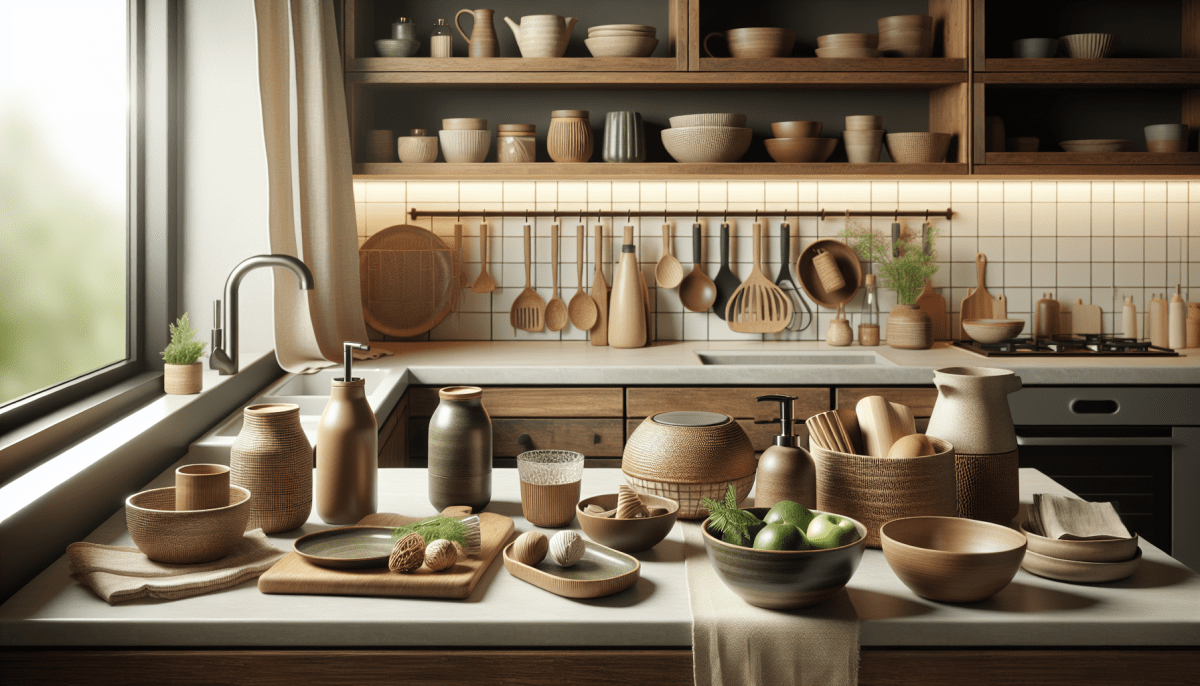The Rise of Eco-Friendly Materials in Kitchenware
As sustainability becomes an increasingly important consideration in our daily lives, it is no surprise that the kitchenware industry is experiencing a rise in the use of eco-friendly materials. With consumers becoming more conscious of their environmental footprint, kitchenware manufacturers are responding by offering products that prioritize sustainability without compromising on functionality or style. Let's explore some of the trends in sustainable kitchenware and the materials leading the way.
Bamboo
In recent years, bamboo has emerged as a popular choice for eco-conscious consumers. This versatile and fast-growing plant is highly sustainable as it requires minimal water, no pesticides, and can be harvested without killing the plant. Bamboo kitchenware, such as cutting boards, utensils, and bowls, are not only durable but also naturally antimicrobial. Moreover, bamboo's aesthetic appeal brings a touch of elegance and warmth to modern kitchens.
Recycled Stainless Steel
Another eco-friendly material making its mark in the kitchenware industry is recycled stainless steel. By using recycled metal, manufacturers help reduce the demand for new resources while still maintaining the durability and hygiene benefits associated with stainless steel. From cookware and utensils to appliances, recycled stainless steel kitchenware offers a long lifespan and can be recycled again at the end of its use, forming a sustainable loop.
Organic Cotton
When it comes to textiles used in kitchenware, organic cotton is gaining popularity as a sustainable choice. Unlike conventional cotton, organic cotton is grown without the use of toxic chemicals or genetically modified organisms, making it safer for both the environment and the workers involved in its production. From tea towels and aprons to reusable food storage bags, organic cotton kitchen textiles offer an eco-friendly alternative to their chemically-treated counterparts while remaining functional and stylish.
Silicone
Silicone, a synthetic material derived from silica (a naturally occurring element), is revolutionizing the kitchenware industry. Its unique properties make it heat resistant, durable, and non-toxic. Silicone has replaced traditional plastics in various kitchen products, including baking mats, oven mitts, and food storage containers. It offers a safer and more sustainable alternative to plastic, reducing the use of harmful chemicals and the generation of plastic waste.
These are just a few examples of the eco-friendly materials that are driving sustainability in kitchenware. As consumers become more conscious of their purchasing choices, the demand for sustainable kitchen products continues to grow. By opting for kitchenware made from renewable, recycled, or organic materials, we can contribute to reducing our environmental impact and create a more sustainable future, one meal at a time.
Innovative Design Solutions for Waste Reduction in the Kitchen
In today's world, where sustainability is a growing concern, individuals and organizations are constantly searching for innovative solutions to reduce waste. The kitchen, being one of the most resource-intensive areas of the household, presents a prime opportunity for implementing sustainable practices. With the rise of sustainable kitchenware, manufacturers and designers have come up with ingenious solutions to ensure waste reduction while maintaining functionality and style.
1. Multi-functional Cookware:
One of the simplest ways to reduce waste in the kitchen is by utilizing multi-functional cookware. Manufacturers are now designing products that can perform multiple cooking functions, reducing the need for separate tools and appliances. For example, a single pan with detachable handles can double as a pot or a baking dish, eliminating the need for extra cookware and streamlining the cooking process.
2. Eco-friendly Materials:
Innovative designers are focusing on incorporating eco-friendly materials into kitchenware. Traditional plastic materials are being replaced with sustainable alternatives like bamboo, cork, or recycled materials. Similarly, utensils made from biodegradable or compostable materials are gaining popularity. By making conscious choices about the materials used in kitchenware, we can contribute to reducing waste and minimizing our carbon footprint.
3. Smart Storage Solutions:
Storage solutions play a significant role in waste reduction. Designers are now creating kitchenware with built-in storage compartments or stackable features, ensuring optimal use of space while also reducing clutter. By maximizing storage efficiency, these innovative designs enable users to easily organize their kitchen essentials, minimizing the risk of food waste due to overlooked or expired items.
4. Portion Control and Food Preservation:
Several innovative designs are aimed at promoting portion control and food preservation in the kitchen. For example, cutting-edge countertop appliances equipped with portion control settings can help individuals cook and serve the right amount of food, reducing waste from leftovers. Similarly, advanced food preservation technologies, such as vacuum sealing and airtight containers, are becoming increasingly popular, preventing food spoilage and reducing the need for single-use plastics like cling wrap or aluminum foil.
5. Composting Solutions:
The issue of food waste can be effectively addressed with innovative composting solutions integrated into kitchenware. Designers are now creating compact composting systems that fit seamlessly into kitchen countertops or beneath sinks. These systems facilitate the decomposition of organic waste, converting it into nutrient-rich compost that can be used for gardening. By incorporating composting solutions into the kitchen, waste is diverted from landfills, and valuable nutrients are returned to the soil.
6. Efficient Water Usage:
Water is a precious resource, and its conservation is crucial in every aspect of our lives, including the kitchen. Designers are now focusing on creating kitchenware that promotes efficient water usage. For instance, faucets equipped with sensors can significantly reduce water wastage by automatically shutting off when not in use. Additionally, dishwashers with water-saving features enable users to clean utensils efficiently while minimizing water consumption.
In conclusion, the sustainable kitchenware industry is making remarkable progress in waste reduction through innovative design solutions. By incorporating multi-functional cookware, eco-friendly materials, smart storage solutions, portion control, food preservation, composting systems, and efficient water usage, consumers can actively contribute to reducing waste in their kitchens. As designers and manufacturers embrace sustainability, the future of kitchenware looks promising, inspiring households around the world to adopt more environmentally responsible practices.
Consumer Demand for Sustainable Kitchenware: From Farm to Table
Consumer Demand for Sustainable Kitchenware: From Farm to Table
In recent years, there has been a noticeable shift in consumer demand towards sustainable kitchenware. As people become more aware of the environmental impact of their lifestyle choices, they are seeking out products that are not only functional but also eco-friendly. From farm to table, sustainable kitchenware encompasses various aspects, including the materials used, manufacturing processes, and the overall lifecycle of the products.
Choosing Sustainable Materials
One of the key factors driving the demand for sustainable kitchenware is the preference for eco-friendly materials. Consumers are actively looking for alternatives to plastic, which has been contributing to the global plastic waste crisis. Sustainable materials such as bamboo, stainless steel, and glass are gaining popularity due to their durability, non-toxic nature, and recyclability. These materials can often be sourced from renewable resources and have a lower carbon footprint compared to traditional options.
Ethical Manufacturing Processes
Another significant aspect of sustainable kitchenware is the implementation of ethical manufacturing practices. Consumers are increasingly concerned about how the products they purchase are made. They want to ensure that the manufacturing processes are transparent, fair, and adhere to stringent environmental standards. Companies that prioritize responsible sourcing, reduce waste during production, and prioritize worker safety are gaining trust among sustainability-conscious consumers.
Lifecycle Considerations
From the moment a product is created, its lifecycle impacts the environment. Consumers are now looking beyond the initial purchase and considering what happens when the product reaches the end of its life. Sustainable kitchenware often incorporates design elements that make products easily recyclable or biodegradable. This helps minimize waste and ensures that the materials do not end up polluting oceans or landfills for years to come. By considering the lifecycle of their kitchenware, consumers can make more informed choices that support long-term sustainability.
The Role of Farming Practices
Sustainable kitchenware extends beyond just the product itself—it also takes into account the farming practices involved in sourcing materials. For instance, consumers are increasingly seeking kitchenware made from sustainably harvested wood or bamboo. These practices ensure that the resources used are replenished rather than contributing to deforestation. Fair trade practices that support farmers and promote biodiversity are also highly valued by conscious consumers.
Embracing the Farm to Table Movement
Consumer demand for sustainable kitchenware aligns with the wider farm-to-table movement, emphasizing the importance of understanding the entire supply chain when it comes to food and cooking. The desire for transparency and responsible practices extends from the ingredients we use to the tools we cook with. By opting for sustainable kitchenware, consumers actively support a holistic approach to sustainability that encompasses both food production and consumption.


